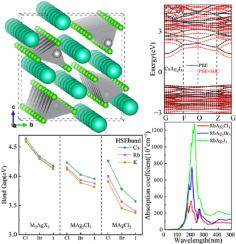三元银基卤化物MlAgmXn的电子和光学性质的第一性原理研究
IF 4.9
3区 材料科学
Q2 CHEMISTRY, MULTIDISCIPLINARY
引用次数: 0
摘要
在本研究中,采用第一性原理计算研究了三元银基卤化物MlAgmXn(M = K, Rb, Cs; X = Cl, Br, I)的结构,电子和光学性质,包括M2AgX3, MAg2X3和MAgX2。结果表明,M2AgX3和MAg2X3呈现直接带隙,而MAgX2呈现间接带隙。通过改变X -离子可以有效地调节带隙,其中M2AgX3的带隙值最大。自旋轨道耦合(SOC)对带隙值的影响随卤化物组成和晶体结构的变化而变化。在近紫外区,随着X -离子从Cl -变为Br -变为I -,吸收增加,其中MAg2X3卤化物在三种结构中具有最高的吸收。总的来说,我们对MlAgmXn卤化物的理论研究通过成分和结构工程提供了有前途的光电可调性,突出了它们潜在的光电应用。本文章由计算机程序翻译,如有差异,请以英文原文为准。

First-principles investigation of electronic and optical properties in ternary silver-based halides MlAgmXn
In this study, first-principles calculations were employed to investigate the structural, electronic, and optical properties of the ternary silver-based halides MlAgmXn(M = K, Rb, Cs; X = Cl, Br, I), including M2AgX3, MAg2X3, and MAgX2. The results reveal that M2AgX3 and MAg2X3 exhibit direct band gaps, while MAgX2 displays an indirect band gap. The band gap can be effectively tuned by varying the X− ions, with M2AgX3 showing the largest band gap value among these three structural types. The influence of spin-orbit coupling (SOC) on band gap values was also evaluated, showing systematic variations with both halide composition and crystal structure. In the near-ultraviolet region, absorption increases as X− ions change from Cl− to Br− to I−, with MAg2X3 halides exhibiting the highest absorption among the three structures. Overall, our theoretical investigation of the MlAgmXn halides offers promising optoelectronic tunability through compositional and structural engineering, highlighting their potential optoelectronic applications.
求助全文
通过发布文献求助,成功后即可免费获取论文全文。
去求助
来源期刊
CiteScore
7.80
自引率
2.50%
发文量
605
审稿时长
40 days
期刊介绍:
The Journal of Physics and Chemistry of Solids is a well-established international medium for publication of archival research in condensed matter and materials sciences. Areas of interest broadly include experimental and theoretical research on electronic, magnetic, spectroscopic and structural properties as well as the statistical mechanics and thermodynamics of materials. The focus is on gaining physical and chemical insight into the properties and potential applications of condensed matter systems.
Within the broad scope of the journal, beyond regular contributions, the editors have identified submissions in the following areas of physics and chemistry of solids to be of special current interest to the journal:
Low-dimensional systems
Exotic states of quantum electron matter including topological phases
Energy conversion and storage
Interfaces, nanoparticles and catalysts.

 求助内容:
求助内容: 应助结果提醒方式:
应助结果提醒方式:


